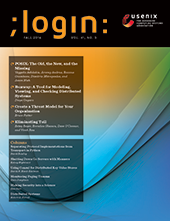USENIX supports diversity, equity, and inclusion and condemns hate and discrimination.
The Networks of Reinvention
;login: Enters a New Phase of Its Evolution
For over 20 years, ;login: has been a print magazine with a digital version; in the two decades previous, it was USENIX’s newsletter, UNIX News. Since its inception 45 years ago, it has served as a medium through which the USENIX community learns about useful tools, research, and events from one another. Beginning in 2021, ;login: will no longer be the formally published print magazine as we’ve known it most recently, but rather reimagined as a digital publication with increased opportunities for interactivity among authors and readers.
Since USENIX became an open access publisher of papers in 2008, ;login: has remained our only content behind a membership paywall. In keeping with our commitment to open access, all ;login: content will be open to everyone when we make this change. However, only USENIX members at the sustainer level or higher, as well as student members, will have exclusive access to the interactivity options. Rik Farrow, the current editor of the magazine, will continue to provide leadership for the overall content offered in ;login:, which will be released via our website on a regular basis throughout the year.
As we plan to launch this new format, we are forming an editorial committee of volunteers from throughout the USENIX community to curate content, meaning that this will be a formally peer-reviewed publication. This new model will increase opportunities for the community to contribute to ;login: and engage with its content. In addition to written articles, we are open to other ideas of what you might want to experience.

Network programming has been a part of Python since its earliest days. Not only are there a wide variety of standard library modules ranging from low-level socket programming to various aspects of Web programming, there are a large number of third-party packages that simplify various tasks or provide different kinds of I/O models. As the network evolves and new standards emerge, though, one can’t help but wonder whether the existing set of networking libraries are up to the task. For example, if you start to look at technologies such as websockets, HTTP/2, or coroutines, the whole picture starts to get rather fuzzy. Is there any room for innovation in this space? Or must one be resigned to legacy approaches from its past. In this article, I spend some time exploring some projects that are at the edge of Python networking. This includes my own Curio project as well as some protocol implementation libraries, including hyper-h2 and h11.

